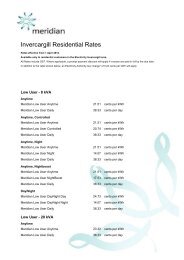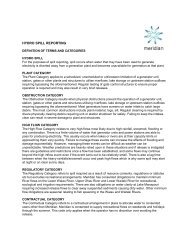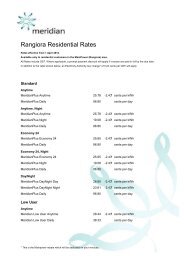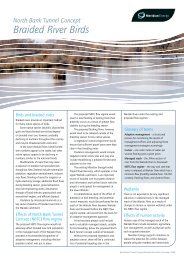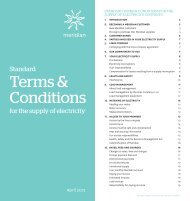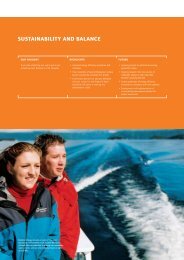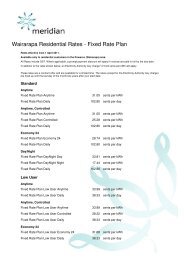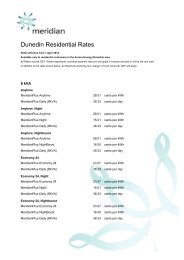Meridian Annual Report - Meridian Energy
Meridian Annual Report - Meridian Energy
Meridian Annual Report - Meridian Energy
You also want an ePaper? Increase the reach of your titles
YUMPU automatically turns print PDFs into web optimized ePapers that Google loves.
46<br />
<strong>Meridian</strong> <strong>Energy</strong> Limited — Notes to the Financial Statements (continued)<br />
available. In relation to forecast prices used to determine cash flow<br />
forecasts for CfD’s for non-observable periods, the following significant<br />
assumptions are used where relevant:<br />
• Forecast of the forward wholesale electricity price for the nonobservable<br />
period based on a fundamental analysis of expected<br />
demand and cost of new supply<br />
• Forecast of the aluminium price (based on the London Metal Exchange<br />
(LME)) for the non-observable period using a historical trend analysis<br />
to form future price expectations<br />
• Forecast CPI or proxy for price inflation<br />
• All CfD’s run to full term<br />
The forecast electricity price path is used to determine a best estimate<br />
of the expected cash flows to be settled on CfD’s. The expected cash<br />
flows are then discounted to determine a fair value of the CfD. The<br />
discount rates used are based on a benchmark BKBM interest rate<br />
adjusted for additional risks including credit risk and the remaining term<br />
of the CfD. In relation to one CfD, the discount rate used is <strong>Meridian</strong>’s<br />
weighted average cost of capital.<br />
The fair value of forward exchange contracts is determined using<br />
forward exchange market rates at balance date discounted to present<br />
value. The fair value of currency options is determined using<br />
appropriate binomial models or the Black-Scholes model.<br />
The fair value of financial liabilities in a fair value hedge relationship<br />
and for the purpose of disclosure is estimated by discounting the future<br />
designated cash flows at current market interest rates applicable to the<br />
risks being hedged.<br />
The valuations determined for instruments not traded on an active<br />
market, particularly in respect to CfD’s, can vary significantly based<br />
on assumptions in relation to the forecast electricity price and interest<br />
rates and in the case of one CfD, fair value can also vary based on the<br />
price of aluminium published on the London Metal Exchange (LME).<br />
The sensitivity to changes in assumptions is quantified in Note 22<br />
– Financial Risk Management.<br />
Reserves<br />
The revaluation reserve arises on the revaluation of generation<br />
structures and plant and from the revaluation of certain intangible<br />
assets as part of the step acquisition of Whisper Tech Group on 3 July<br />
2006 (refer Note 13(b)). Where revalued generation structures or plant<br />
assets are sold, that portion of the asset revaluation reserve which<br />
relates to that asset, and is effectively realised, is transferred directly<br />
to retained profits. Where a revalued intangible asset is sold that<br />
portion of the reserve which relates to that intangible asset, and is<br />
effectively realised, is transferred directly to retained earnings. Where<br />
a revalued intangible asset is impaired the impairment is recognised<br />
in the reserve to the extent of any surplus for that asset otherwise the<br />
impairment is recognised in the income statement.<br />
The hedging reserve comprises the effective portion of the cumulative<br />
net change in the fair value of cash flow hedging instruments relating<br />
to hedged transactions that have not yet occurred. The cumulative<br />
deferred gain or loss on the hedge is recognised in the income<br />
statement when the transaction impacts the profit and loss, or is<br />
included as a basis adjustment to the non-financial hedged item,<br />
consistent with the applicable accounting policy.<br />
The foreign currency translation reserve comprises all foreign currency<br />
differences arising from the translation of the financial statements of<br />
independent foreign operations.<br />
The available-for-sale revaluation reserve arises on the revaluation<br />
of available-for-sale financial assets. Where a revalued asset is sold<br />
that portion of the reserve which relates to that financial asset,<br />
and is effectively realised, is recognised in the income statement.<br />
Where a revalued financial asset is impaired, the impairment is<br />
recognised in the reserve to the extent of any surplus for that asset,<br />
otherwise the impairment is recognised in the income statement.<br />
Taxation<br />
Income tax expense represents the sum of the tax currently payable<br />
and deferred tax.<br />
The tax currently payable is based on taxable profit for the period.<br />
Taxable profit differs from profit as reported in the income statement<br />
because it excludes items of income and expense that are taxable or<br />
deductible in other years and it further excludes items that are never<br />
taxable or deductible.<br />
Deferred Tax<br />
Deferred tax is recognised on differences between the carrying amounts<br />
of assets and liabilities in the financial statements and the<br />
corresponding tax bases used in the computation of taxable profit, and<br />
is accounted for using the balance sheet liability method. Deferred tax<br />
liabilities are generally recognised for all taxable temporary differences<br />
and deferred tax assets are recognised to the extent that it is probable<br />
that taxable profits will be available against which deductible temporary<br />
differences can be utilised. Such assets and liabilities are not recognised<br />
if the temporary difference arises from goodwill or from the initial<br />
recognition (other than in a business combination) of other assets and<br />
liabilities in a transaction that affects neither the taxable profit nor the<br />
accounting profit.<br />
Deferred tax liabilities are recognised for taxable temporary differences<br />
arising on investments in subsidiaries and associates, and interests in<br />
joint ventures, except where <strong>Meridian</strong> is able to control the reversal of<br />
the temporary difference and it is probable that the temporary<br />
difference will not reverse in the foreseeable future.<br />
The carrying amount of deferred tax assets is reviewed at each balance<br />
date and reduced to the extent that it is no longer probable that<br />
sufficient taxable profits will be available to allow all or part of the asset<br />
to be recovered.<br />
Deferred tax is calculated at the tax rates that are expected to apply in<br />
the period when the liability is settled or the asset realised. Deferred tax<br />
is charged or credited to the income statement, except when it relates<br />
to items charged or credited directly to equity, in which case the<br />
deferred tax is also dealt with in equity.<br />
Deferred tax assets and liabilities are offset when there is a legally<br />
enforceable right to set off current tax assets against current tax<br />
liabilities and when they relate to income taxes levied by the same<br />
taxation authority and <strong>Meridian</strong> intends to settle its current tax assets<br />
and liabilities on a net basis.<br />
Employee Benefits<br />
Provision is made for benefits accruing to employees in respect of wages<br />
and salaries, annual leave, long service leave, and employee incentives<br />
when it is probable that settlement will be required and they are<br />
capable of being measured reliably.<br />
Provisions made in respect of employee benefits are measured using<br />
the remuneration rate expected to apply at the time of settlement.



